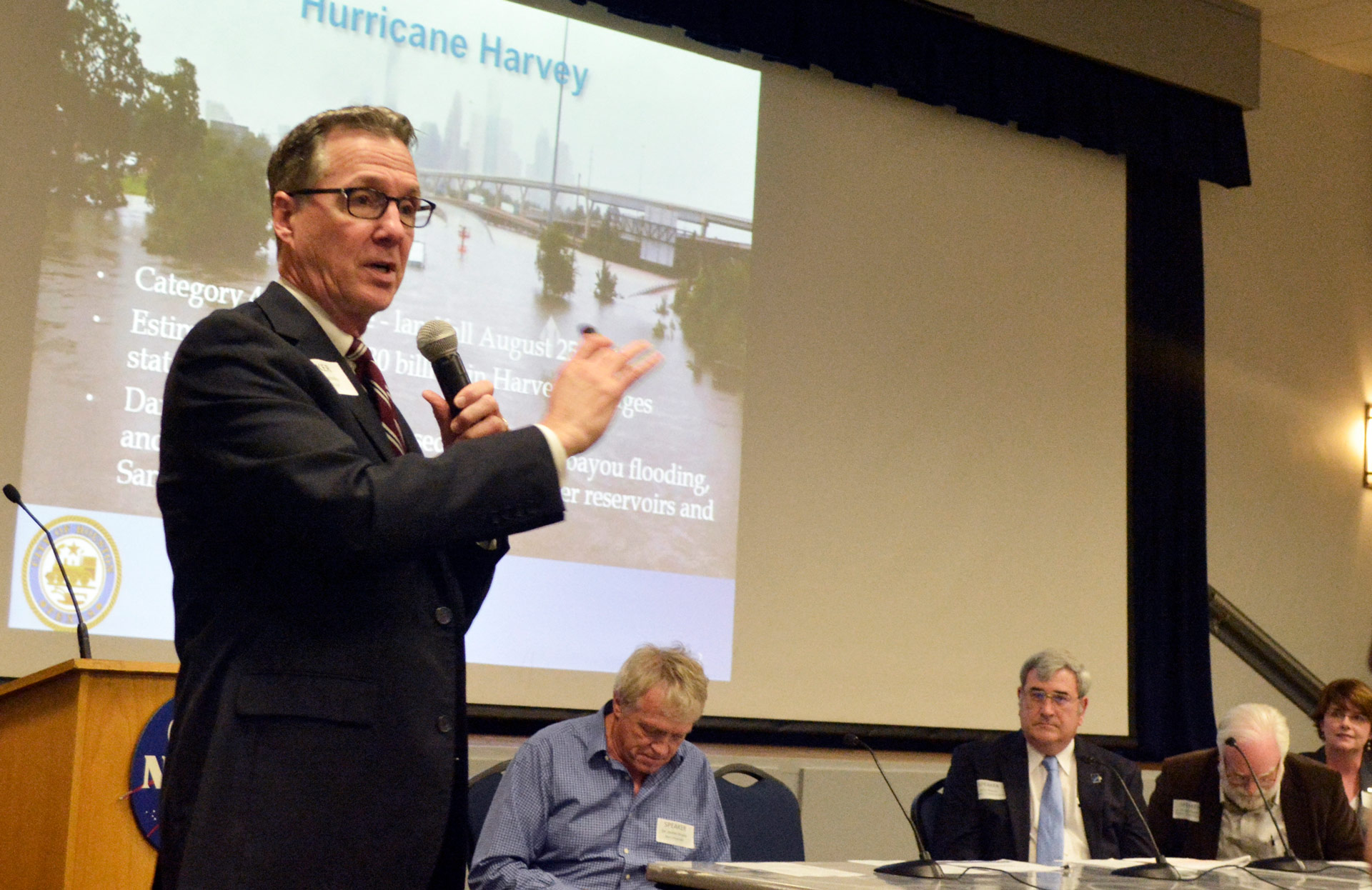- Future Students
- How to Apply
- Visit UHCL
- Admitted Students
- Tuition, Costs and Aid
- Degrees and Programs
- Contact Admissions
- Current Students
- Class Schedule
- Academic Calendar
- Advising
- Events
- Library
- Academic Resources and Support
- Student Services and Resources
- Alumni
- Lifetime Membership
- Alumni Events
- Update Your information
- Awards and Recognitions
- Give to UHCL

Hurricane Harvey has become a call to action for public servants, policy advisers, scientists, engineers and others as they seek ways to mitigate future disasters. Experts and community leaders fielded questions from more than 200 concerned citizens – many of whom are still recovering from flood damage – during the “The Houston | Bay Area Storm Water Flooding Forum: Harvey, Ike and the Future,” which was co-sponsored by the University of Houston- Clear Lake’s Environmental Institute of Houston.
Other co-sponsors included the American Institute of Aeronautics and Astronautics and grassroots community organizations Americans United in Action and Houston Region Concerned Citizens.
The August storm shattered records thought not possible – topping 60 inches of rain in some areas for a total estimated 33 trillion gallons of water. The result was a 1,000-year flood event that inflicted $200 billion in damage, displaced more than 30,000 people and caused more than 80 deaths.
So how does a community prepare for the next “impossible” catastrophe? By making difficult choices, the experts said, decisions that will affect development, private and public investments, where tax dollars are spent and no less than the region’s future landscape.
“If we look back in the history of our community, here and other parts of Texas, we can see that a lot of this was probably avoidable,” said Environmental Institute of Houston Executive Director George Guillen, who opened the forum and acted as master of ceremonies.
“But to avoid previous mistakes and to ensure that our tax dollars are invested in the most effective manner, residents, decision makers, elected officials have to make knowledgeable informed decisions. Decisions that are rooted in good science and good engineering,” he added.
The event was held Nov. 28 at the Gilruth Center on Space Center Blvd. The forum was broken into two panels. The first panel discussed the challenges of downstream flooding; the second panel focused on rising sea levels and storm surge.
Panelists included Stephen Costello, chief resilience officer for the City of Houston. An engineer with a background in flood control and former Houston city council member, Costello joined the mayor’s office as “flood czar” following the 2016 “Tax Day” floods.
Costello said that much of Greater Houston was built along watersheds long before the first 100-year floodplain maps were drawn – and added that 40 percent of the homes flooded by Harvey weren’t in any designated floodplain. “Harvey was unique because it really changed the dynamics of a particular flood and how we regulate development within floodplains,” he said.
“For years we have been advocating for infrastructure investment in storm water reductions. It falls on deaf ears – both in terms of the public as well as the political leadership. Why is that? Because historically when we have a flood it only impacts a small percentage of the community,” he said.
He pointed out that the 2015 and 2016 floods only impacted isolated areas of Houston. “Ninety percent of the city didn’t flood. So 90 percent of the people really weren’t paying much attention to the rainfall event,” he said.
Prior to 2015, flood events were typically seven to eight years apart. “Even the people who had flooded and who had recovered, who had rebuilt, seven or eight years later have really forgotten about it. That was a challenge for people who advocate for infrastructure investment,” he said.
One such investment was discussed by John Branch, president of the Clear Lake Water Authority, who reported on the ongoing transformation of the former Clear Lake Golf Course into a multipurpose greenspace/water detention area called Exploration Green. Only about 80 percent complete, the detention ponds were credited with mitigating some of Harvey’s flooding in surrounding neighborhoods. The water authority purchased the defunct golf course in 2011 following a $28 million bond vote. After permits were obtained, the agency began construction in 2015.
Panelists included Lisa Gonzalez, president and CEO of the Houston Advanced Research Center, John Jacob, director of the Texas Coastal Watershed Program at Texas A&M University, Bob Stokes, director of Galveston Bay Foundation, Andre Droxler, director of the Center for the Study of Environment and Society at Rice University, and others.
For more information about the Environmental Institute of Houston, including video footage and archived presentations from the majority of presenters at the forum, visit www.uhcl.edu/environmental-institute/flood-forum.






